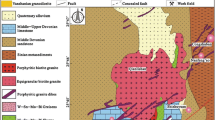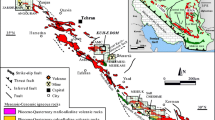Abstract
Several precious metal-bearing, low sulfidation epithermal veins occur in the rolling topography of the Osilo area, northern Sardinia. The Sa Pala de Sa Fae and the Sa Pedra Bianca veins were subject to intense diamond drilling exploration in the mid 1990 s. The veins extend for 1–3 km, dip steeply, and range from 1 to 10 m in width. High K-calc-alkaline volcanic deposits containing plagioclase phenocrysts (along with lesser pyroxene, amphibole, magnetite, olivine and sanidine) form the main host rocks. Gold grades in drill intersections range from <0.1 to <20 ppm, with silver-gold ratios of around 4 to 7. Mineralogical studies show a systematic distribution of three hydrothermal mineral assemblages. At distances >50 m from the vein, the assemblage albite + Fe-chlorite + illite + pyrite (± montmorillonite ± calcite ± K-feldspar) prevails regionally, and its formation is attributed to minor metasomatism of the country rock involving the addition of water, carbon dioxide and hydrogen sulfide. At distances <10 m from the vein, the assemblage quartz + K-feldspar + pyrite ± illite dominates, forming an alteration envelope that cross cuts regional alteration. Quartz and K-feldspar increase in abundance towards the vein. Quartz is the main vein mineral, and it displays a range of morphologies and textures including crustiform colloform banding, quartz pseudomorphs of platy calcite, breccias and coarse euhedral crystals. Electrum and argentite which are the main gold and silver minerals deposited during the early stages of vein mineralization with rhomb-shaped crystals of K-feldspar (adularia). Pyrite, plus lesser marcasite, arsenopyrite, stibnite and sphalerite, are the other sulfide phases in veins. Kaolinite ± halloysite ± jarosite form a late assemblage overprinting earlier hydrothermal alteration. It is mostly restricted to shallow depths of a few meters, except near veins. Most of this assemblage likely formed from weathering and oxidation of sulfides. Microthermometric measurements were made on quartz-hosted, two-phase (liquid + vapor) inclusions, containing ∼75% liquid; mean homogenization temperatures (∼750 measurements) range from 220 to 250 °C, and ice-melting temperatures (∼550 measurements) range from 0.0 to −2.3 °C. The presence of co-existing vapor-rich and liquid rich inclusions, with quartz pseudomorphs of platy calcite, indicate that boiling conditions existed. Slight vapor-bubble expansion of a few fluid inclusions subjected to crushing experiments indicates inclusion fluids contained variable but low concentrations of dissolved gas. This study shows that gold-silver mineralization formed in subvertical channels from ascending solutions at 250 °C at around 300 to 450 m below the paleo-water table in a typical low-sulfidation epithermal environment. Hydrothermal solutions that produced vein mineralization and related alteration were dilute (<4.1 equivalent wt.% NaCl and <4 wt.% CO2), near neutral pH, reduced and, at times, boiling.
Similar content being viewed by others
Author information
Authors and Affiliations
Additional information
Received: 19 May 1998 / Accepted: 8 March 1999
Rights and permissions
About this article
Cite this article
Simeone, R., Simmons, S. Mineralogical and fluid inclusion studies of low-sulfidation epithermal veins at Osilo (Sardinia), Italy. Mineral. Deposita 34, 705–717 (1999). https://doi.org/10.1007/s001260050229
Published:
Issue Date:
DOI: https://doi.org/10.1007/s001260050229




